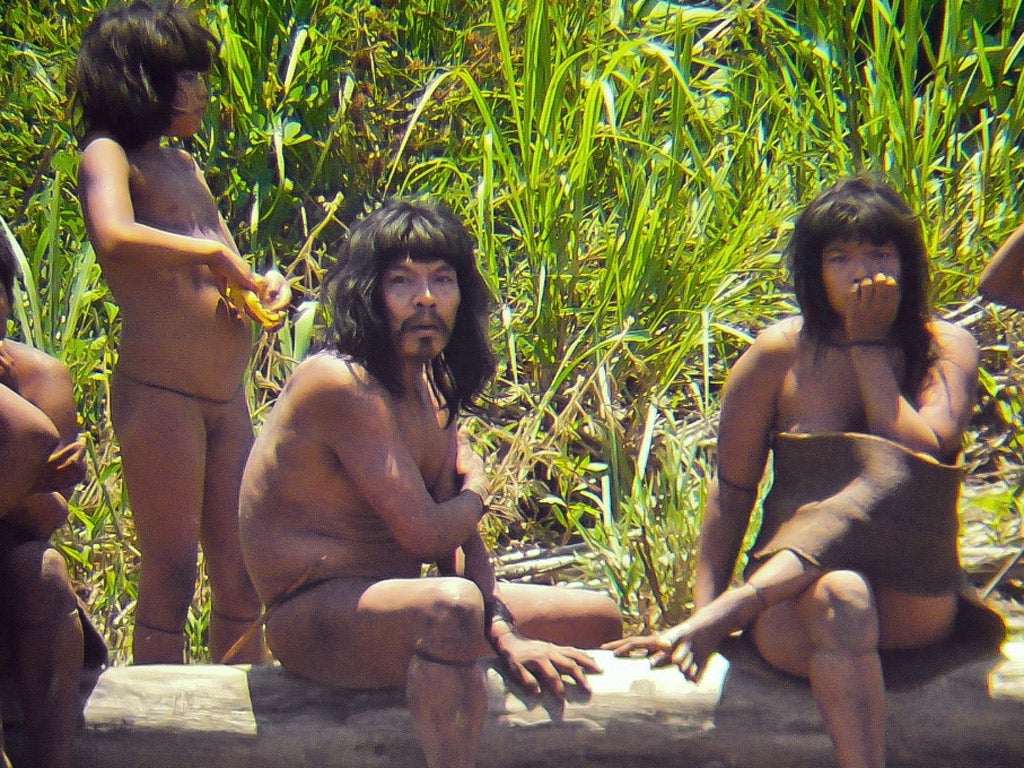New pictures have emerged of the Mashco Piro, a rarely-seen uncontacted Indigenous tribe in the remote Peruvian Amazon, amid concerns that logging activity is forcing them out of the dense rainforest more frequently.
Survival International, a nonprofit advocating Indigenous rights, released images showing members of the reclusive tribe on the banks of a river near logging concessions.
Fenamad, an Indigenous rights group, said that the Mashco Piro have been venturing out in search of food, driven away by the expanding logging activities.
The pictures, taken at the end of June, show the tribe along a river in the Madre de Dios region, close to the Brazilian border.
“These incredible images show that a large number of isolated Mashco Piro live alone a few kilometres from where the loggers are about to start their operations,” Survival International’s director Caroline Pearce said.
“Indeed one logging company, Canales Tahuamanu, is already at work inside Mashco Piro territory, which the Mashco Piro have made clear they oppose.”

“This is irrefutable evidence that many Mashco Piro live in this area, which the government has not only failed to protect but actually sold off to logging companies,” Alfredo Vargas Pio, head of Fenamad, said. “The logging workers could bring in new diseases which would wipe out the Mashco Piro, and there’s also a risk of violence on either side, so it is very important the territorial rights of the Mashco Piro are recognised and protected in law.”
A group of over 50 Mashco Piro has been spotted near a Yine village in Monte Salvado in recent days. Another group of 17 Mashco Piro has been seen close to the nearby village of Puerto Nuevo, Survival International said.

The Mashco Piro, who live between two natural reserves in Madre de Dios, rarely venture out and have limited interaction with the Yine or other tribes in the region.
The Yine, who are not uncontacted, speak a language related to Mashco Piro and have previously reported that the reclusive tribe angrily denounced the presence of loggers on their land, Survival International said.
Several logging companies hold timber concessions on the Mashco Piro territory.

Survival International said “loggers working for Canales Tahuamanu are not only penetrating deep into the forest, they have also constructed around 200 kilometres of logging roads”.
“Such roads are historically disastrous in the Amazon, providing an easy way into the previously inaccessible rainforest for colonisation and settlement,” the nonprofit said on its website.
It said “loggers do not report sightings of the Mashco Piro, for fear of having their operations shut down. A Mashco Piro man told one Yine villager, ‘The men wearing orange are bad people.’ The loggers wear orange jumpsuits.”
Canales Tahuamanu is reportedly licensed to manage nearly 53,000 hectares of forest in Madre de Dios for extracting cedar and mahogany.

“This is a humanitarian disaster in the making. It’s absolutely vital that the loggers are thrown out and the Mashco Piro’s territory is properly protected at last,” Ms Pearce said, demanding the Peruvian authorities immediately cancel the company’s licence.
“Failure to do so will make a mockery of the entire certification system.”
According to Survival International, Canales Tahuamanu “has aggressively used the courts to defend its logging activities”.
“In one particularly galling move, they even sued to prevent the Yine entering the rainforest that they share with the Mashco Piro, claiming that since it is protected, the Yine were trespassing.”
The Peruvian government announced on 28 June that local villagers had spotted Mashco Piro near the Las Piedras river, 150km from Puerto Maldonado, the capital of Madre de Dios.
Sightings of the tribe have been reported in Brazil as well, according to Rosa Padilha of the Brazilian Catholic Bishops’ Indigenous Missionary Council in Acre.
“They flee from loggers on the Peruvian side. At this time of the year they appear on beaches to take tracajá eggs,” she said, using the local word for the Amazon turtle. “That’s when we find their footprints on the sand. They leave behind a lot of turtle shells.”
Ms Padilha described them as “a people with no peace, restless, because they are always on the run.”
Indigenous organisations in Peru have long campaigned for expanding the Mashco Piro’s reserve.
All relevant government departments had approved the expansion by 2016 and it was awaiting a presidential decree, Survival International said. But the decree remains unsigned, allowing logging to continue.

